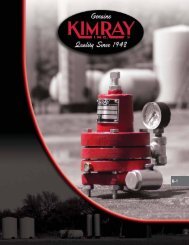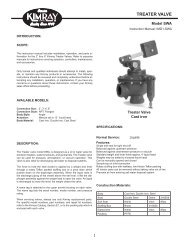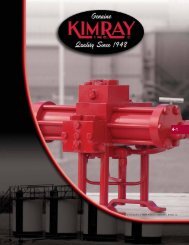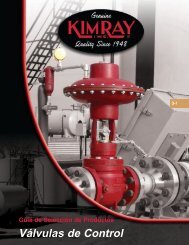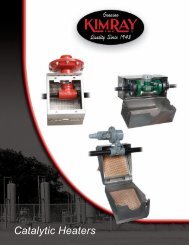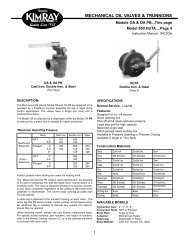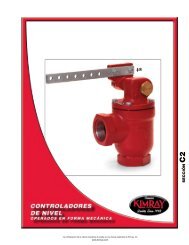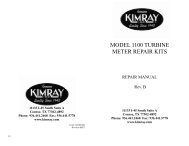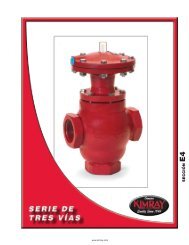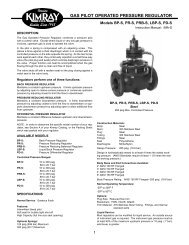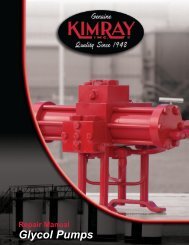PLC LEVEL CONTROLLER - Home | Kimray Mobile
PLC LEVEL CONTROLLER - Home | Kimray Mobile
PLC LEVEL CONTROLLER - Home | Kimray Mobile
- No tags were found...
Create successful ePaper yourself
Turn your PDF publications into a flip-book with our unique Google optimized e-Paper software.
<strong>PLC</strong> <strong>LEVEL</strong> <strong>CONTROLLER</strong>Models 100,200 & 400 <strong>PLC</strong>Instruction Manual: IMF1<strong>PLC</strong>INSTALLATION CONT:BEFORE INSTALLATION:Be sure you fully understand the application, operation, and connectionof the device before installing.WARNING:Only trained personnel should install or service a control valve orcontrol device. Control valves and other control devices shouldbe installed, operated, and maintained in accordance with internationalcodes and regulations, manufacturer’s instructions, andproven best practices.Personal injury, equipment damage, property damage, leakage, orbursting of pressure-containing parts may result if the controlleris overpressured or installed where service conditions could exceedthe limits given in the SPECIFICATIONS section.Overpressure protection should also be provided if the valve inletpressure may exceed the safe working pressure of the equipmentdownstream.To avoid injury or damage, install pressure-relieving or pressurelimiting devices to prevent service conditions from exceedingthose limits. Consult the appropriate code, regulations, or standards.Consideration should be given to the potential risk of injury orproperty damage due to escaping fluid. To avoid such risks, installthe controller in a safe location.ADJUSTMENT:The <strong>PLC</strong> liquid pilot has one adjustment for controlling liquid level ina vessel. In order to increase liquid level in vessel tighten adjustmentknob on top of pilot. This will compress spring on top of diaphragmcausing more diaphragm resistance to liquid head level. To decreaseliquid level in vessel simply loosen adjustment knob.START-UP AND TEST:Warning:Before performing any service be sure that the regulator is fully isolatedand that all pressure upstream and downstream has been relieved.Use bypass valves or fully shut off the process.Be sure that any operating or instrument gas lines have been disconnected.Never assume that a check valve is fully blocking the downstream line.Never tighten any fitting or the main connections to the regulator whilethere is pressure on the line.NOTE:When a gasket seal is disturbed during disassembly a new gasketshould be installed during reassembly to ensure proper sealing.MAINTENANCE:Maintenance should be performed on a regular basis. An initial inspectioninterval of 12 months is recommended. Depending on the serviceconditions and the condition of the valve, the inspection interval may bedecreased or increased.Warning: If the pilot vents fluid or a leak develops inthe system, it indicates that service is required. Failureto take the pilot out of service immediately maycreate a hazardous condition.Repair kits are available. Consult the <strong>Kimray</strong> Catalog, Section F, or thepacking slip which is enclosed with each pilot for the correct Repair Kitnumber.REPAIR HINTS:* If pilot bleeds gas continuously, the pilot plug seat may be dirty.* Diaphragms will harden with age.* Pressure differential above 20 psi across main diaphragm couldcause it to rupture.With installation completed and appropriate relief and check valvesinstalled and set, slowly open the upstream and downstream shutoffvalves. In order to verify liquid level a sight glass will need to be installed.Make sure supply gas is turned on to pilot.1. Start with adjustment screw half way turned in. this will be approximately6” above <strong>PLC</strong> pilot.2. Verify that liquid dump valve opens when liquid level in tank is above<strong>PLC</strong> pilot.3. Once operation of liquid dump valve is verified, use adjustment screwand sight glass to set liquid level in vessel.3



